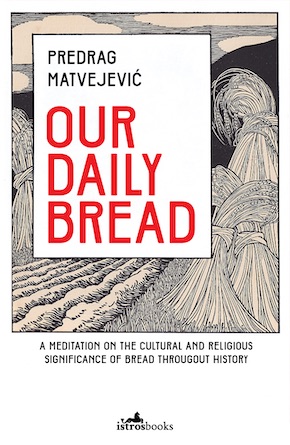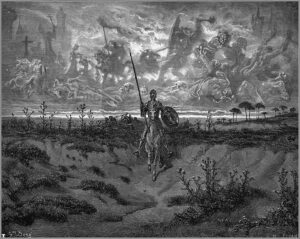Bread and circuses
by Predrag Matvejević
“A wonderful and miraculous journey… an anthropological, but also a literary, historical and linguistic experiment.” La Repubblica
Historians say that during the fourteenth century Europe lost one-third of its population in seven years. The roads were strewn with unburied corpses. In the worst times of famine and despair, people used their ingenuity to grind anything they thought could replace grain, flour and bread. In their endeavour to keep making bread, they did not just resort to the poorest varieties of grain, such as spelt, oats, millet and buckwheat; records show that people also used huge amounts of poppyseed, acorns, carobs and chestnuts, chickpeas, broad beans and lentils, sesame, sunflower, caraway, coriander and anise seeds and who knows what else. Such mixtures produced a sluggishness and drowsiness in both the body and mind very different from the usual nutritional value of ordinary bread. More upsetting still, certain weeds and roots, grasses and nettles, mixed with wild legumes and vetch, and sometimes even with sand, earth and sawdust, had a fatal effect. Crushed or ground and then turned into a mash that was either boiled or baked, they caused fevers, nightmares, dizziness, insomnia, visions of witches, vampires, “black angels” and all sorts of delusions. There were epidemic waves of scrofula, convulsions, coughing, diarrhoea, delirium, the black plague, and the swollen, red lymph node (buboes) in the armpit of a person with bubonic plague. Flies, lice, bedbugs and various vermin carried infections from one region to another. A terrible time for all people, from the numberless vagrants and beggars roaming from village to village and fair to fair in the hope of stealing or cajoling out of someone a crust of bread, to those behind prison bars – inmates who lived on bread and water, losing weight and becoming weak, yet managing to survive, sometimes for a long time, because even the poorest bread provided what their bodies needed. When the pilgrims travelling to the Holy Land strayed from their path and saw the pyramids, they were said to have imagined that they were seeing huge granaries and to have envied the locals for what they thought was their glut of bread.
The world of medicine has always tried to help the starving and sick. Hippocrates had already described how hunger and illness could affect the body and its movements; the same hands that kneaded the dough and baked the bread would make the same movements even when there was nothing there to knead or bake. Medieval physicians and pharmacists provided advice and instructions, advising against hunger, Pracepta contra famem, but it was all in vain when famine ruled. There was even a sixteenth-century Italian comedy titled Banchetto de’ malcibati (“Banquet of the Poorly Fed”). Performed as part of the Commedia dell’arte’s repertoire in city after city, the play’s jester, giullare, endowed the characters with such ironic names as Lady Famine, Messer Small Harvest, Lady Poverty and so on. The wobbly table in performances of the “The Court of Miracles” held only scraps of bread. The medieval myth of “The Land of Cockaigne”, promising a fantastic land of plenty, mutated into a pathetic carnival. Processions became funerals; monasteries, alms houses; prayers, laments; pilgrims, martyrs; and ascetics, corpses. Poverty identified with popular theatre on the open stage and the pundits heralded the end of the world, while the chroniclers foresaw the Apocalypse.

‘Venitore di pane’ (unattributed). Welcome Collection
The picaro leaves his native town with his face and eyes hollowed out by hunger, for it has been a long time since he tasted even a crumb of bread.”
Poverty and destitution were also at the root of the picaresque novel, a genre of prose fiction that depicts the adventures of a hero of low social class who lives by his wits in a corrupt society, which was popular from the mid-1500s until the eighteenth century. The picaro (Spanish: picaresca, from pícaro, “rogue” or “rascal”) leaves his native town with his face and eyes hollowed out by hunger, for it has been a long time since he tasted even a crumb of bread. He leaves with no destination, roaming around markets, fairs and alms houses, living by his wits by “pinching” whatever he can find. “Bread and bulls” (pan y toros) is the Spanish version of an old Latin saying (panem et circenses – “bread and circuses”). The character of the student who has not yet graduated is preserved in the annals of history, he who knows the works of Aristotle and Avicenna but not anything that will be of practical help to him. He is called a capiggorista because of the cloak around his shoulders and cap on his head. Thin and frail, he is always rushing somewhere, looking for something, usually a crust of bread. The records show that Madrid’s markets, and especially its bakeries, were repeatedly ravaged, and in Castilla, vagabonds were called “lost bread” (pan perdido) and beggars, “grasshoppers” (saltamontes). Begging, like prostitution, required a permit that was strictly limited to the given area.
Cervantes’ “Knight of the Sad Countenance” sought consolation in bread: “All sorrows are less with bread” (los duelos con pan son menos). Perhaps that Knight of the Sad Countenance fought windmills because they hadn’t ground enough grain to feed the starving. And perhaps Sancho Panza rode his donkey dreaming of bread.
Like writers, painters depicted bodies that were weak and pale, looks that were sad and lost. In his youth, El Greco travelled from the island of Crete, where he was born in 1541, to Toledo, where he was to become famous. He painted the starving Christians he encountered along the way. In Florence, pre-Renaissance paintings bore witness to the suffering of the city’s people. Venetian artists were more cheerful. La Serenissima, which imported and sold grains, managed to avoid the disaster of famine, if not of the plague. It is easily noted that virtually all the bodies depicted on Byzantine icons from the late Middle Ages are emaciated.

Illustration by Gustave Doré for an 1863 edition of Cervantes’ Don Quixote, Hachette & Co., Paris. Wikimedia Commons
The Jews expelled from Spain by the Inquisition were accused, among other things, of wanting to bring Christians closer to their own faith by offering them unleavened bread with the coming of Passover. The non-Christians being transported by Genovese galley ships to the Ottoman Empire or the countries of the Maghreb, the Balkans, Istanbul, Smyrna, Thessaloniki or Sarajevo, cried out for a piece of ship’s biscuit even if roaches had already nibbled at it first. However, the Sephardim and Marranos (from the word marrano, which means “pig” in Spanish) did not forget their matzah or how their ancestors had made it. Some moved northwards, where the great Rembrandt saw their wan, gaunt faces. Indeed, some of his drawings followed the work of the scholar Rabbi Menasseh ben Israel, with whom he shared the bread of friendship. In Amsterdam at that time, one could also hear the voice of Baruch Spinoza: Deus sive natura, “God or nature”. Bread is connected to both.
Over time, modern machines increasingly started doing the work of sowers and reapers, millers and bakers, women and mothers. Production became “industrialized” and the products “banalized”, at the cost of quality. Virgil was neither the first nor the last poet to complain that the bread made in big cities had lost its taste. He wondered why it was so different from the bread of his childhood in Mantua, which he ate with moretum (translated as “salad” but more like a pesto). In his Dictionary of Received Ideas, Gustave Flaubert indignantly wrote: “Nobody knows what filth goes into bread!”
Bread was a staple food; everything else was merely an accompaniment, a companatico, as the Romans say. In modern times, the roles have reversed and it is bread that is now more of a side order. Today it allows us to trace a line between the poor and the rich: the former want more bread and the latter are happy to give it up.
From Our Daily Bread (Istros Books, £10.99)
 Predrag Matvejević (1932–2017) was a writer and scholar of international renown, born in Mostar, Bosnia & Herzegovina. Throughout his long academic career he taught Slavic literature at the University of Paris III: Sorbonne Nouvelle from 1991 to 1994 and then moved on to the Sapienza University of Rome until 2007. He is best known for his non-fiction book Mediterranean: A Cultural Landscape (University of California Press, 2000), a seminal work of cultural history of the Mediterranean region which has been translated into more than 20 languages. He is also the author of over twenty books of essays. Our Daily Bread (published as Pane Nostro/Kruh Nas) won the Premio Internazionale De Lollis award in 2009. A year before he passed away, a group of Italian writers including Umberto Eco and Claudio Magris nominated Matvejević for The Nobel Prize in Literature. Our Daily Bread, translated by Christina Pribichevic-Zorić is published by Istros Books.
Predrag Matvejević (1932–2017) was a writer and scholar of international renown, born in Mostar, Bosnia & Herzegovina. Throughout his long academic career he taught Slavic literature at the University of Paris III: Sorbonne Nouvelle from 1991 to 1994 and then moved on to the Sapienza University of Rome until 2007. He is best known for his non-fiction book Mediterranean: A Cultural Landscape (University of California Press, 2000), a seminal work of cultural history of the Mediterranean region which has been translated into more than 20 languages. He is also the author of over twenty books of essays. Our Daily Bread (published as Pane Nostro/Kruh Nas) won the Premio Internazionale De Lollis award in 2009. A year before he passed away, a group of Italian writers including Umberto Eco and Claudio Magris nominated Matvejević for The Nobel Prize in Literature. Our Daily Bread, translated by Christina Pribichevic-Zorić is published by Istros Books.
Read more
@Istros_books
Christina Pribichevic-Zorić has translated over 35 translated works of fiction and non-fiction from Serbian/Croatian and French into English, and is a recipient of the Serbian PEN Award for Translation, the Djuro Daničić Award for Translation and Radio Yugoslavia’s Award for Outstanding Achievement. She is a member of the Board of Trustees at the Media Diversity Institute, London, English PEN and the Advisory Board of the Central & East European Book Project, Amsterdam. She is the translator of Filip David’s The House of Remembering and Forgetting and Marina Šur Puhlovski’s Wild Woman for Istros Books.

